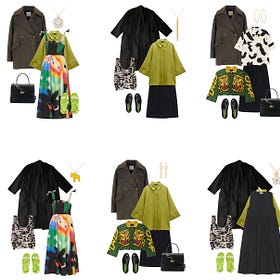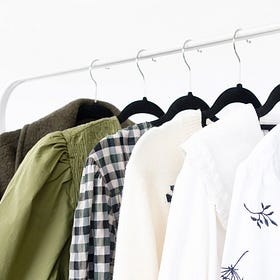How I Lost My Personal Style (And Found It Again)
Why blending in is boring and being weird is worth it.
I used to dress like myself.
Then I started following the rules and forgot who I was.
I read every “how to find your personal style” guide. Made Pinterest boards. Bought the versatile staples. Decluttered anything that didn’t “spark joy.”
I followed the minimalists and the influencers who said: elevated basics, versatile essentials, and neutrals only. No fun. No weirdness. No personality.
My wardrobe became a checklist. Perfect on paper but dead behind the eyes. And I didn’t even notice, until one day I looked at it and realised: nothing in there said anything about me.
I thought I was doing it right. But instead of confidence, I felt invisible. I’d shopped “intentionally,” followed every formula—and ended up with someone else’s wardrobe.
Because personal style isn’t something you find by following someone else’s checklist. Especially not one written by people selling you another beige jumper.
So I began unlearning it all. Unsubscribed from minimalist blogs. Unfollowed influencers. Started again—with colour, character, and clothes I actually wanted to wear.
This isn’t another how-to. It’s just what happened when I stopped listening to what everyone else said I should wear—and started trusting what I actually liked.
Not into paid subscriptions? Buy me a virtual coffee or shop my jewellery — it’s a nice way to say thanks, no strings attached 🖤
How I Lost My Personal Style
When I started my sustainable jewellery brand, I thought I was just making a small change—a rebellion against mass-produced tat.
Then I watched The True Cost, a documentary that delivers a gut-punch straight to your conscience. Suddenly, it wasn’t just jewellery that needed rethinking. It was everything.
So I did what anyone with a guilty conscience and a wardrobe full of Zara might do. I panicked. I decluttered. I started over.
Back then, capsule wardrobes were for minimalists, not influencers selling seasonal edits. The kind of people who believed that the key to a good life was owning very little. The promise was seductive: intentional living with fewer things, more peace. And I ate it up.
For a chronic shopaholic, it felt revolutionary.
But minimalism treats fashion like a guilty pleasure. Something shallow you’re supposed to grow out of. As if enjoying your clothes is frivolous. A distraction from the serious work of becoming a better person.
The Challenge of Buying Less
Back in 2019, I set myself a challenge: buy everything second-hand. Clothes, homewares, electronics… If I needed it, I had to thrift it. I called it my year of second-hand, and it completely changed …
Slowly, without realising, I started to dress like someone with no opinions about anything.
The colour drained from my wardrobe. The character vanished. I’d traded fun for function, creativity for coordination. A bland rotation of practical basics took over. Everything “put together” but that said absolutely nothing about me as a person.
Then sustainability went mainstream, influencers swapped hauls for capsules. Suddenly, social media was flooded with beige trench coats, black jumpers, perfect jeans. Timeless! Elevated! Linked in bio!
This wasn’t about wearing what you already had. It wasn’t about shopping less. It was consumerism in new packaging.
Capsule wardrobes became just another marketing tool for influencers who shared curated lists of must-haves—neutral, bland, and soulless—killing creativity and smothering personal style.
No wonder people pushed back.
Capsule Wardrobes Are Still the Answer
Is anyone actually still following those generic capsule wardrobe guides? You know the ones: "How To Build A Minimalist Closet" or "10 Essentials Everyone Needs." Because they keep being referenced a…
To be clear, minimalism and capsule wardrobes can be helpful.
But taken to the extreme—or worse, turned into monetised templates—they become something else entirely. What started as a rebellion against mindless consumerism became a subtle new version of it.
All the creativity disappears. The self-expression. The joy.
Fashion isn’t just functional. It’s personal.
And no one’s personality is beige.
And How I Found It Again
I'd started a blog, A Considered Life. Quit fast fashion. Built a capsule wardrobe. I was doing everything “right.” But at some point, I looked at my wardrobe and realised something had gone very wrong. Not because I had nothing to wear. But because none of it felt like me.
All the quirky thrift finds, the weird little details, the fun pieces were all gone. I still think about that embroidered blazer I decluttered because I’d “only worn it a few times.” It was hideous. I loved it. But I let it go because some stranger said I didn’t need it.
The capsule wardrobe guides shared by influencers didn’t help me shop less. They just gave me more reasons to buy. Every season I chased the next “perfect piece” that would finally complete my wardrobe.
But if you’re constantly shopping for your capsule wardrobe, it’s not a capsule. It’s just a wardrobe!
The Newness You’re Looking For Isn’t in Your Cart
Buying something new feels good. That little rush when you click “add to cart” isn't an accident. You’ve been groomed by capitalism into thinking shopping is a hobby. That new = better. That having more = being more.
I’d outsourced my taste. Followed guides written by people who looked great in jeans and a T-shirt and assumed I would too.
Without the weird pieces—the clashing prints, the accidental finds, the stuff that makes no sense but just works—my style got boring.
Those perfect basics were fine in theory but totally dull in reality. So I stopped listening to people who think navy is a bold choice, and I let my wardrobe get weird again.
Once I saw how much of my style was shaped by outside pressure, I rebuilt it on my own terms: strange, playful, interesting. All the things the “style experts” with their capsule checklists told me to avoid.
I stopped second-guessing my taste. I stopped asking, Will this go with everything? and trusted that if I loved it, I’d find a way to wear it. And I always did.
The Independent Brands In My Wardrobe
After spending a whole year buying only second-hand, I’m convinced that with enough time, it's possible to thrift anything. The thrill of finding a unique, one-of-a-kind piece or finally scoring that…
Because personal style isn’t a formula or something you “find.” It’s something you practice. Through trial and error. Living your life. Reflecting who you are—not who you’re told to be.
That’s why I started creating capsule wardrobe guides based on my actual clothes. To show that small wardrobes can have personality. Sustainable style doesn’t mean dressing in grayscale.
Turns out, style isn’t about owning the right pieces. It’s about trusting your taste—and wearing what you actually like.








Love this! I felt the same way! I thought buying "basics" and timeless pieces would be better , but I ended up just looking like everyone else. Like a uniform and it's like we all lost individuality. I started to add colors and patterns and graphic tees back into my wardrobe (thrifted of course) because that's what gets me excited. I love fashion and I thought you couldn't love fashion and be conscious about the environment. But now I know that you can still love fashion and embrace your style by buying secondhand or sewing your own outfits! ✨️
Conforming to other’s rules “just because” brings me misery. I wholeheartedly advocate for setting your own framework.